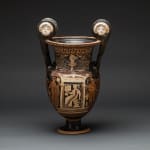Apulian Red-Figure Volute Krater, 400 BCE - 300 BCE
Terracotta, Pigment
height 54.6 cm
height 21 1/2 in
height 21 1/2 in
AM.0036
Further images
The volute krater, named after the shape of its handles, was originally employed for mixing wine with water. Many elaborately decorated examples, such as this, though, also acquired a funerary...
The volute krater, named after the shape of its handles, was originally employed for mixing wine with water. Many elaborately decorated examples, such as this, though, also acquired a funerary destination, a function which seems to be confirmed by the decorative theme of both sides.
On the obverse a draped female figure, identified as the deceased, is seated within an Ionic naiskos. To the right a naked wreathed male figure with a chlamys over his left arm, carries a bunch of grapes and a laurel crown. On the left, a draped female figure is holding a mirror. Both these figures are offering gifts to the deceased. On the back side, two draped male figures, each holding an ivy leaf, are standing on either side of a funerary monument decorated by ribbons.
The figures are flanked on both sides by a palmettes while the volutes of the handles are decorated by ornamental human faces. A motif of vertical lines enhances the shoulder of the krater, with the depiction of a female head enclosed by vines and rosettes, on the principal side of the neck.
An exceptional vessel, whose decoration reflects the spiritual preoccupations of the 4th century BC and the concern for the afterlife.
On the obverse a draped female figure, identified as the deceased, is seated within an Ionic naiskos. To the right a naked wreathed male figure with a chlamys over his left arm, carries a bunch of grapes and a laurel crown. On the left, a draped female figure is holding a mirror. Both these figures are offering gifts to the deceased. On the back side, two draped male figures, each holding an ivy leaf, are standing on either side of a funerary monument decorated by ribbons.
The figures are flanked on both sides by a palmettes while the volutes of the handles are decorated by ornamental human faces. A motif of vertical lines enhances the shoulder of the krater, with the depiction of a female head enclosed by vines and rosettes, on the principal side of the neck.
An exceptional vessel, whose decoration reflects the spiritual preoccupations of the 4th century BC and the concern for the afterlife.







